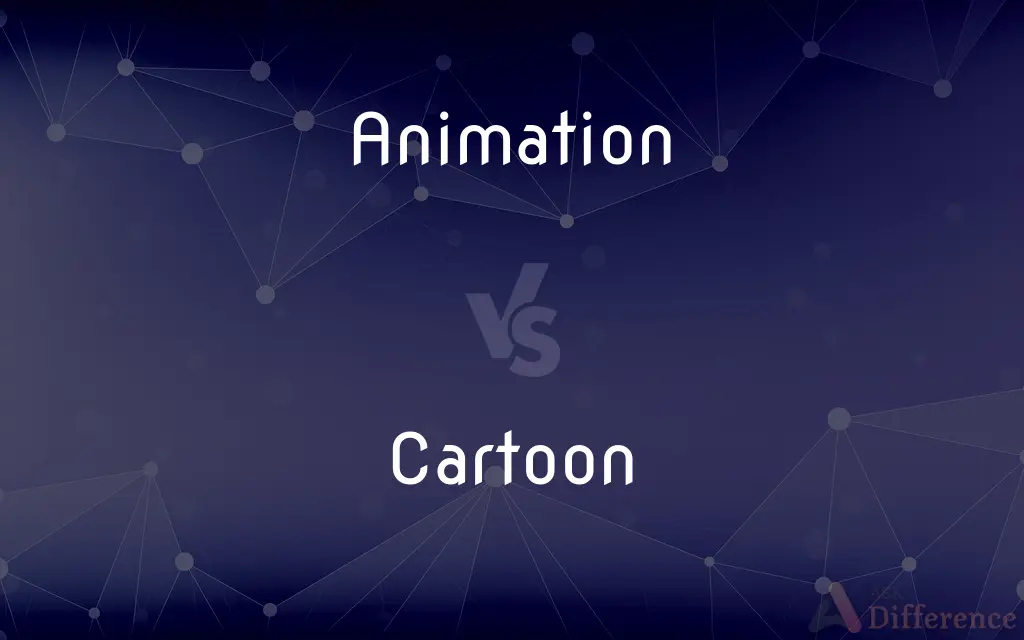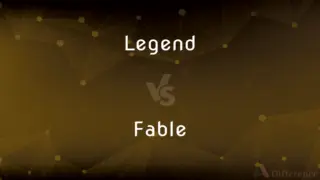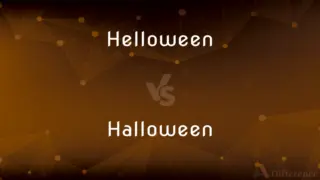Animation vs. Cartoon — What's the Difference?
By Fiza Rafique & Maham Liaqat — Updated on March 24, 2024
Animation refers to the process of creating the illusion of motion by displaying a series of pictures or frames. Cartoon, on the other hand, is a style of animation characterized by exaggerated features and a comedic or fantastical theme.

Difference Between Animation and Cartoon
Table of Contents
ADVERTISEMENT
Key Differences
Animation encompasses a wide range of techniques and styles used to create the illusion of motion by rapidly displaying a sequence of static images that minimally differ from each other. This process can be applied in various mediums including film, television, and digital platforms. Whereas, cartoons are a subset of animation, specifically designed to be stylized, humorous, or satirical drawings or illustrations. Cartoons are often aimed at both children and adults, relying on exaggeration and caricature for effect.
While animation can be created using a variety of methods including traditional hand-drawn techniques, stop-motion, and computer-generated imagery (CGI), cartoons are traditionally hand-drawn or computer-generated with a distinctive style that emphasizes exaggerated physical features and often vibrant colors. On the other hand, animations can also strive for realistic details and textures, especially in CGI for movies and video games.
Animation is used across a wide range of genres, from realistic and dramatic storytelling to educational content. It's not confined to humor or simplistic storytelling. Cartoons, however, are primarily known for their role in entertainment, often characterized by fantastical elements, slapstick comedy, and satirical tones, making them particularly popular in children's programming and comic strips.
Animations are present in various formats including movies, TV shows, web series, and video games, showcasing a broad spectrum of thematic content from simple stories for children to complex narratives aimed at adults. Cartoons, while they can be found in these formats as well, are more commonly associated with shorter formats like TV shows for children and comic strips, focusing on lighter, more comedic content.
The audience for animation is vast and varied, catering to all age groups with content that ranges from educational to mature themes. Cartoons typically target a younger audience or those young at heart, with their content often reflecting a more light-hearted, humorous approach to storytelling.
ADVERTISEMENT
Comparison Chart
Definition
The technique of photographing successive drawings or positions of puppets or models to create an illusion of movement.
A simple drawing showing the features of its subjects in a humorously exaggerated way, especially a satirical one in a newspaper or magazine.
Technique
Can involve hand-drawn, CGI, stop-motion, and more.
Often hand-drawn or CGI, with exaggerated features.
Purpose
Can range from storytelling, education, to entertainment.
Primarily for humor, satire, or caricature.
Target Audience
All age groups, depending on content.
Often children and families, but can appeal to all ages with a focus on humor.
Style
Can vary widely, from realistic to highly stylized.
Characterized by stylization and exaggeration, often colorful.
Compare with Definitions
Animation
A method of making a movie by using a series of drawings, computer graphics, or photographs of objects.
The animation of the movie was so lifelike it felt real.
Cartoon
A comic strip or a series of drawings, often animated, in a newspaper or magazine.
His favorite cartoon featured a clever cat and a foolish dog.
Animation
The process of bringing a character or scene to life through movement.
Animation in video games has evolved significantly over the years.
Cartoon
A humorous or satirical drawing, sometimes animated, especially one in a newspaper or magazine.
The cartoonist's work often comments on social issues.
Animation
The act of imparting motion to something .
The engineer was fascinated by the animation of mechanical parts.
Cartoon
A motion picture using animation techniques to photograph a sequence of drawings rather than real people or objects.
Saturday mornings were reserved for watching cartoons.
Animation
Techniques that allow objects to appear as if they are moving in a real-world space.
Stop-motion animation requires patience and precision.
Cartoon
Artwork prepared for animation, often character-driven and stylized.
She studied cartoon art to become an animator.
Animation
The state of being full of life or vigor; liveliness .
Her face was a portrait of animation as she told the story.
Cartoon
A simple drawing showing the features of its subjects in a humorously exaggerated way.
The political cartoon sparked much debate.
Animation
Animation is a method in which figures are manipulated to appear as moving images. In traditional animation, images are drawn or painted by hand on transparent celluloid sheets to be photographed and exhibited on film.
Cartoon
A cartoon is a type of illustration that is typically drawn, sometimes animated, in an unrealistic or semi-realistic style. The specific meaning has evolved over time, but the modern usage usually refers to either: an image or series of images intended for satire, caricature, or humor; or a motion picture that relies on a sequence of illustrations for its animation.
Animation
The act, process, or result of imparting life, interest, spirit, motion, or activity.
Cartoon
A drawing depicting a humorous situation, often accompanied by a caption.
Animation
The quality or condition of being alive, active, spirited, or vigorous.
Cartoon
A drawing representing current public figures or issues symbolically and often satirically
A political cartoon.
Animation
The art or process of making movies with drawings, computer graphics, or photographs of static objects, including all techniques other than the continuous filming of live-action images.
Cartoon
A preliminary sketch similar in size to the work, such as a fresco, that is to be copied from it.
Animation
Images or special effects created through animation.
Cartoon
A usually short, animated movie or television program.
Animation
The act of animating, or giving life or spirit.
Cartoon
An animated character in a movie or television program.
Animation
The technique of making inanimate objects or drawings appear to move in motion pictures or computer graphics; the object (film, computer game, etc.) so produced
Cartoon
A comic strip.
Animation
The state of being lively, brisk, or full of spirit and vigor; vivacity; spiritedness
He recited the story with great animation.
Cartoon
A ridiculously oversimplified or stereotypical representation
Criticized the actor's portrayal of Jefferson as a historically inaccurate cartoon.
Animation
The condition of being animate or alive.
Cartoon
To draw a humorous or satirical representation of; caricature.
Animation
(linguistics) conversion from the inanimate to animate grammatical category
Cartoon
To make humorous or satirical drawings.
Animation
Activities offered by a holiday resort encompassing activities that include movement, joy, leisure and spectacle, such as games, sports, shows, events, etc.
Cartoon
(comics) A humorous drawing, often with a caption, or a strip of such drawings.
Animation
The act of animating, or giving life or spirit; the state of being animate or alive.
The animation of the same soul quickening the whole frame.
Perhaps an inanimate thing supplies me, while I am speaking, with whatever I possess of animation.
Cartoon
(comics) A drawing satirising current public figures.
Animation
The state of being lively, brisk, or full of spirit and vigor; vivacity; spiritedness; as, he recited the story with great animation.
Cartoon
(arts) An artist's preliminary sketch.
Animation
The condition of living or the state of being alive;
While there's life there's hope
Life depends on many chemical and physical processes
Cartoon
(arts) A full-sized drawing that serves as the template for a fresco, a tapestry, etc.
Animation
The property of being able to survive and grow;
The vitality of a seed
Cartoon
(animation) An animated piece of film which is often but not exclusively humorous.
Animation
Quality of being active or spirited or alive and vigorous
Cartoon
A diagram in a scientific concept.
Animation
The activity of giving vitality and vigour to something
Cartoon
To draw a cartoon, a humorous drawing.
Animation
The making of animated cartoons
Cartoon
(arts) To make a preliminary sketch.
Animation
General activity and motion
Cartoon
A design or study drawn of the full size, to serve as a model for transferring or copying; - used in the making of mosaics, tapestries, fresco pantings and the like; as, the cartoons of Raphael.
Cartoon
A large pictorial sketch, as in a journal or magazine; esp. a pictorial caricature; as, the cartoons of "Puck."
Cartoon
Same as comic strip.
Cartoon
A motion picture consisting of a series of frames, each being a photograph of a drawing rather than a frame produced by filming a scene of true action, and in which the objects are displaced slightly in succeeding frames so as to give the appearance of motion when projected as a motion picture on the screen. The types of characters portrayed in such films are often similar or identical to those in a comic strip.
Cartoon
A humorous or satirical drawing published in a newspaper or magazine
Cartoon
A film made by photographing a series of cartoon drawings to give the illusion of movement when projected in rapid sequence
Cartoon
Draw cartoons of
Common Curiosities
How do animations differ from cartoons?
Animations encompass a broader range of techniques and purposes, including storytelling and educational content, while cartoons are typically humorous and stylized subsets of animation.
What defines a cartoon?
A cartoon is a form of two-dimensional illustrated visual art, often characterized by exaggerated features and used for satire, humor, or entertainment.
Are cartoons only for children?
No, while cartoons often target children, many are created with adult themes and humor.
What is animation?
Animation is the technique of creating the illusion of motion by displaying a sequence of images or frames.
What techniques are used in animation?
Techniques include traditional hand-drawn, CGI, stop-motion, and rotoscoping, among others.
How has animation evolved over the years?
Animation has evolved from simple hand-drawn images to complex CGI and virtual reality, expanding in scope and technique.
Are there educational cartoons?
Yes, many cartoons are designed with educational content for children, teaching various subjects in an engaging way.
Can cartoons be considered animations?
Yes, cartoons are a specific style of animation, mainly known for their exaggerated, humorous characteristics.
What role do cartoons play in media?
Cartoons play a significant role in media, offering commentary on society, politics, and human behavior through humor and satire.
Do animations always have to be movies or TV shows?
No, animations can also be in the form of web series, video games, and interactive media.
What's the main purpose of cartoons?
The main purpose is to entertain, often through humor, satire, or caricature.
What's the difference between CGI and traditional animation?
CGI is computer-generated, allowing for 3D animation and realistic textures, while traditional animation is hand-drawn, frame by frame.
Can the style of a cartoon affect its audience?
Yes, the style can influence its appeal, making it more suitable for certain age groups or tastes.
How do animations and cartoons impact culture?
They reflect and influence cultural trends, values, and societal norms through their themes and narratives.
What makes an animation or cartoon successful?
Success can come from compelling storytelling, relatable characters, humor, artistic quality, and the ability to connect with the audience emotionally.
Share Your Discovery

Previous Comparison
Legend vs. Fable
Next Comparison
Helloween vs. HalloweenAuthor Spotlight
Written by
Fiza RafiqueFiza Rafique is a skilled content writer at AskDifference.com, where she meticulously refines and enhances written pieces. Drawing from her vast editorial expertise, Fiza ensures clarity, accuracy, and precision in every article. Passionate about language, she continually seeks to elevate the quality of content for readers worldwide.
Co-written by
Maham Liaqat













































